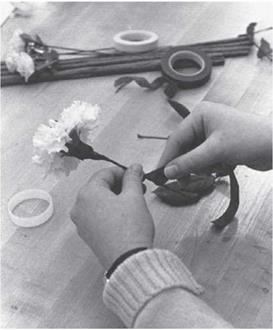It is common practice among florists to wire certain flowers prior to their use in designs. Fresh, dried, and permanent (artificial) flowers and foliage may all be wired. The wire must not show after the flowers are arranged, so it is concealed with foliage and floral tape.
Flowers are wired for several reasons:
• to support stems weakened by age or poor production
• to straighten crooked stems
• to hold stems in an intentional curve for a design
• to extend stem length for large arrangements
• to replace a bulky stem, permitting use of the flower in a corsage
• to combine single blossoms for a mass effect
|
Wiring technique |
Example of flowers |
||
|
Wire inside a hollow stem |
Bulb flowers such as tulips, daffodils, hyacinths, and gladioli |
||
|
Wire in the calyx and around the stem |
Roses, carnations, large mums |
||
|
Wire looped through the neck of a blossom and around a wad of moistened cotton |
Moist cotton |
Tubular, fragile flowers such as stephanotis |
|
|
3 |
|||
|
Wire through the calyx and the ends bent to form a replacement stem |
T ¥ і f |
Flowers with a thick, strong calyx such as carnations and roses |
|
|
Wire through the calyx, formed into a hook, and ~ |
Flowers with weak stems and flattened heads such as daisies, pom pom mums, and black-eyed susans |
|
figure 7-13. Techniques for wiring flowers (Delmar/Cengage Learning) |
|
|
figure 7-14. Floral tape is applied after the flower has been wired. It is stretched tightly to ensure a secure fit. (Delmar/Cengage Learning.
Photo by Jack Ingels.)
The techniques of wiring depends on the flower being wired. More precisely, it depends on the type of stem and flower head involved (Figure 7-13).
After wiring, the wires may require taping to cover them or disguise them to resemble stems. To apply the tape, hold the wired flower and stem in one hand while the other hand applies the floral tape from the base of the calyx downward (Figure 7-14). The tape is stretched tight as the flower is twirled.




